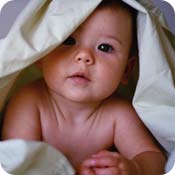 The best crib, that top-of-the-line swing, the highest-rated car seat, and the driest diapers on the market--you want the best for your baby. Of course you want a healthy environment that supplies clean air and water for your little one too. Here are some facts for you to ponder when choosing between cloth and disposable.
The best crib, that top-of-the-line swing, the highest-rated car seat, and the driest diapers on the market--you want the best for your baby. Of course you want a healthy environment that supplies clean air and water for your little one too. Here are some facts for you to ponder when choosing between cloth and disposable.
For Your Baby
When it comes to your baby's well-being, cloth diapers defeat the competition. Here are four reasons why:
- Cloth diapers allow for the circulation of air, while disposables don't. This is important for baby's comfort and his or her developing reproductive organs-especially in boys, whose testicles are located outside their body for the precise reason of keeping them cool. A few studies have actually linked disposable diaper use with the recent worldwide decline in sperm count.
- While the liner of disposable diapers is designed to keep moisture away from baby's skin, the bacteria and acids from urine still hang around baby's delicate skin. Because modern disposable diapers are super-absorbent, many parents leave these diapers on their baby for extended periods of time, allowing the bacteria to multiply.
- Babies who wear cloth feel the sensation of a wet diaper as soon as they pee, so they're more aware of their body functions. On average, a cloth-diapered baby potty trains one year sooner than her disposable-diapered counterpart, which is better for everyone!
- In 1955, 100 percent of American babies wore cloth diapers, and only seven percent experienced diaper rash. In 1991, 10 percent of American babies wore cloth diapers, 90 percent wore disposables, and 78 percent experienced diaper rash.
For Your Wallet
Cloth diapers, especially the fitted and all-in-one varieties, are a big investment up front. But even with a top-notch diaper layette, the savings still adds up, especially when you consider that well-made cloth diapers will last through multiple children. Estimates vary on exactly how much you save when using cloth diapers, but there's no doubt that it's a bundle. Here's an example of how much you can save by cloth-diapering your bundle of joy, who will use 6,500 diapers by the time he is potty trained:
$1,820 to $2,730: Total cost of disposable-diapering your baby for 2-1/2 years
$615: Total cost of cloth-diapering your baby for 2-1/2 years:
- $225: Minimum price of cloth diaper layette with three-dozen diapers (enough to wash only two to three times per week), diaper covers and fasteners.
- $390: Cost of washing and drying cloth diapers (270 loads of 24 diapers at $1.45 per load).
$1,205 to $2,115: Total savings if you cloth-diaper your baby.
This savings can vary a great deal depending on what type of diapers you buy, energy costs, age of potty training, and if you use the cloth diapers for multiple children. As you can see, cloth diapers make cents!
For the Environment
In the era of disposable everything, eco-conscious parents may feel like they're blazing a new trail by choosing reusable products like cloth diapers and cloth wipes for their babies. But interest in and demand for cloth-diapering products is on the rise, probably due in part to the realization of the impact our disposable culture has on the planet. Besides being better for your baby's skin and better for your budget, cloth diapering is better for the planet. Assuming your baby is in diapers for two-and-a-half years, using disposable diapers will generate at least two tons of waste. Here are more facts about the ecological impact of disposable diapers:
- Disposable diapers go straight to the landfills. Once there, it takes 500 years for one single-use disposable diaper to decompose. Currently, disposable diapers make up the third largest single consumer item in our landfills, and account for 30 percent of the non-biodegradable waste in landfills. On the other hand, cloth diapers are reusable. Not only can you wash them and reuse them on your baby, but you can also use them on your next baby, and then as household rags when they're too tired for babies. This slows the pileup of our already overburdened landfills. When no longer usable, a cloth diaper will decompose within six months.
- Disposable diapers are made of wood pulp, which eats up one billion trees per year at current manufacturing rates. But cloth diapers are made from a wide variety of natural and sustainable materials like organic cotton, hemp, bamboo, wool and more.
- The wastewater from the manufacture of disposable diapers contains dioxins (which have been linked to birth defects, miscarriages, cancer and genetic damage), solvents, and heavy metals. While the human waste in disposable diapers is forever preserved in our landfills (joining the other 5 million tons of untreated human waste there), the human waste of a cloth-diapered baby is properly treated in a sanitary municipal wastewater treatment plant. The wastewater produced from washing cloth diapers is benign.
- According to the Canadian Cloth Diaper Association, "disposable diapers consume 70 percent more energy than the average reusable diaper per diaper change." The extra water required to wash cloth diapers is actually less than the amount of water it takes to produce disposable diapers.
Sure these are lots of great reasons to try cloth, but if you feel a little overwhelmed, you're not alone. Contrary to popular belief, cloth diapers don't have to be confusing, expensive, difficult to use, or inconvenient; and yes, working parents can fit cloth diapering into their busy lifestyles. If you're ready to get started on your cloth-diapering venture, read Cloth Diapering 101.
|
 The best crib, that top-of-the-line swing, the highest-rated car seat, and the driest diapers on the market--you want the best for your baby. Of course you want a healthy environment that supplies clean air and water for your little one too. Here are some facts for you to ponder when choosing between cloth and disposable.
The best crib, that top-of-the-line swing, the highest-rated car seat, and the driest diapers on the market--you want the best for your baby. Of course you want a healthy environment that supplies clean air and water for your little one too. Here are some facts for you to ponder when choosing between cloth and disposable.


.jpg)


Member Comments